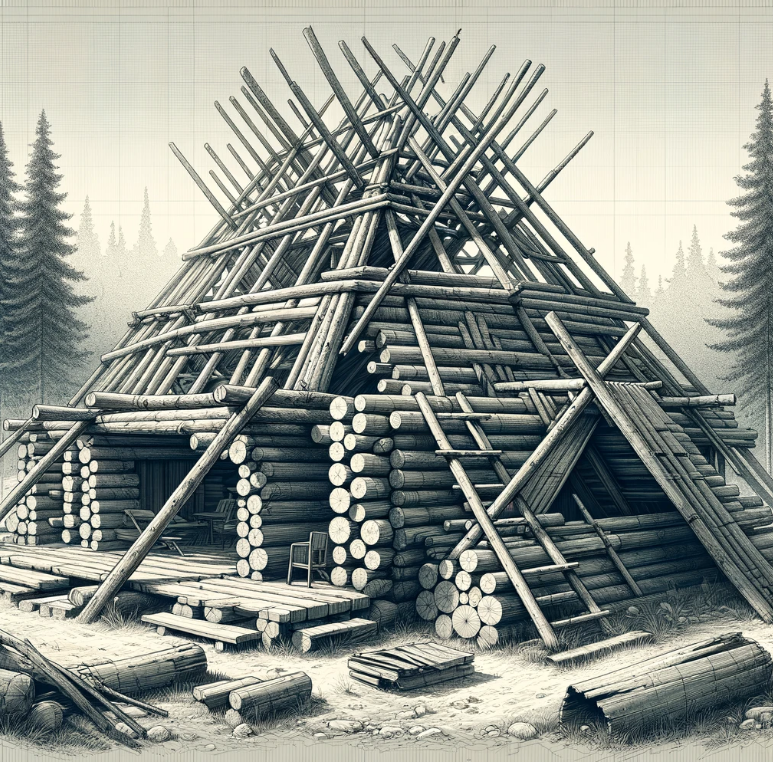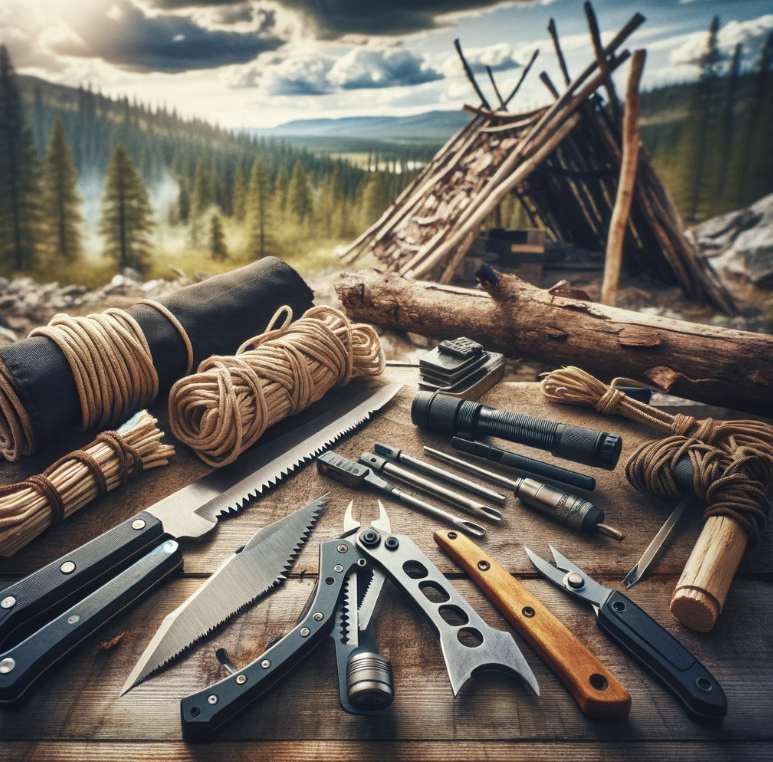Table of Contents
- 1 Introduction to DIY Survival Shelter Techniques for Preppers and Survivalists
- 2 Importance of Shelter in Survival Situations
- 3 Assessing Your Environment for Shelter Building
- 4 Basic Shelter Designs for Immediate Needs
- 5 Advanced Shelter Building Techniques
- 6 Utilizing Natural Resources and Man-Made Materials
- 7 Shelter Building Tools Every Prepper Should Have
- 8 Common Mistakes to Avoid in Shelter Construction
- 9 Practicing and Improving Your Shelter Building Skills
- 10 Closing Thoughts on DIY Shelter Building Tools, Tips and Techniques for Preppers and Survivalists
- 11 Frequently Asked Questions
- 11.1 What are the essential shelter building tools every prepper should have?
- 11.2 How can one assess their environment for shelter building?
- 11.3 What are some common mistakes to avoid in shelter construction?
- 11.4 Why is practicing and improving shelter building skills important?
- 11.5 How can one utilize natural resources along with man-made materials for shelter construction?
Views: 0
Introduction to DIY Survival Shelter Techniques for Preppers and Survivalists
Importance of Shelter in Survival Situations

Shelter is vital for protecting individuals from extreme weather conditions like rain, wind, or snow. In this article we will discover some DIY survival shelter techniques for preppers and survivalists. Learn expert tips, essential tools, techniques, and more. It also shields them from potential dangers in the environment. Having a shelter creates a sense of security and significantly enhances the chances of survival during emergencies.
Properly constructed shelters help regulate body temperature, preventing conditions like hypothermia or heatstroke.
Building shelters is an essential skill for preppers and survivalists preparing for emergency situations. Understanding how to construct shelters ensures self-reliance when facing challenging environments. Preppers and survivalists recognize the significance of possessing both the knowledge and tools required to build effective shelters.
Importance of Shelter in Survival Situations
Shelter is crucial for survival as it helps regulate body temperature and provides safety. Protection from extreme weather conditions like rain, wind, snow, or intense sunlight is essential to prevent hypothermia or sunburn. A well-constructed shelter acts as a barrier against external elements that can harm the body.
Moreover, shelters offer a safe haven away from potential threats such as wild animals or hazardous terrains. In survival situations, having a secure place plays a critical role in maintaining physical health by shielding individuals from the harsh environment. The significance of shelter goes beyond mere protection; it directly impacts one’s ability to endure challenging circumstances and stay resilient.
Discussing the critical role shelter plays in maintaining body temperature and providing safety
- Shelter serves as a protective shield against extreme temperatures.
- It aids in regulating body heat and preventing hypothermia.
- By offering refuge from harsh weather conditions, shelters reduce the risk of sunburn.
Highlighting the psychological benefits of having a secure place in stressful environments:
- Secure shelters help lower anxiety levels during survival scenarios.
- They provide comfort and stability amidst unfamiliar surroundings.
- The psychological benefits contribute to mental well-being and overall resilience.
Assessing Your Environment for Shelter Building
Tips on Evaluating Natural Resources and Environmental Conditions
When constructing a shelter in the wilderness, it’s crucial to assess your surroundings. Start by scanning for resources like trees, rocks, or caves that can be used in building. Take note of the terrain, wind patterns, water sources, and potential hazards nearby.

Understanding the climate and weather conditions is essential for selecting suitable materials and shelter design. For instance, in cold climates, you might opt for insulated materials like leaves or pine needles to keep warm. In hot regions, using lightweight materials with proper ventilation can help maintain a comfortable temperature inside the shelter.
How to Choose a Safe and Strategic Location for Your Shelter
Selecting an appropriate location is key when building a shelter outdoors. Look for elevated areas or natural barriers that shield from harsh elements such as strong winds or heavy rain. Avoid spots susceptible to flooding, landslides, or falling objects which could jeopardize safety.
Consider visibility when picking a spot; being visible makes it easier for rescue teams to locate you if needed. Choose locations where signaling distress signals like smoke or mirrors can be easily seen by passing aircraft or search parties.
Basic Shelter Designs for Immediate Needs
Overview of simple shelter designs that can be constructed quickly

Shelter building tools, and techniques that save lives often revolve around basic designs such as lean-tos, A-frames, or tarp shelters. These structures are known for their simplicity and versatility in various environments. Constructing these shelters requires minimal time and effort due to the use of readily available materials like branches, leaves, or tarpaulins.
These basic shelter designs are crucial in emergency situations where immediate protection is needed from the elements. Lean-tos provide a quick overhead cover by leaning branches against a supportive structure. A-frames offer a more enclosed space with two sloping sides meeting at the top. Tarp shelters utilize waterproof materials to create a makeshift roof over your head.
Step-by-step guide on building a lean-to shelter and a debris hut
To build a lean-to shelter, start by placing one end of long branches against a standing tree trunk while angling them towards the ground. Layer smaller sticks across these main supports before adding leaves or other foliage for insulation. Ensure to leave an opening facing away from prevailing winds for better protection.
Constructing a debris hut involves creating an arched framework using sturdy sticks planted into the ground in an elongated oval shape. Cover this frame with layers of leaves, moss, and additional debris until no gaps remain between materials to maximize insulation properties. To enhance waterproofing, consider adding an extra layer of larger leaves or bark on top.
Advanced Shelter Building Techniques
Tips, tricks, and instructions for constructing more durable shelters such as a log cabin or a semi-permanent teepee.
Constructing advanced shelters involves utilizing sturdy materials like logs or stones to ensure long-term survival. For instance, building a log cabin provides excellent durability and protection against the elements. To create one, start by selecting straight and sturdy logs for the structure’s framework.

Next, interlock the logs at the corners using notches for stability. This technique enhances the shelter’s strength and longevity compared to basic designs. Similarly, semi-permanent teepees offer robustness with their conical shape that helps in shedding rainwater efficiently. By following step-by-step instructions carefully when assembling these structures, individuals can significantly improve their chances of survival in challenging environments.
- Pros:
- Enhanced durability
- Superior protection from harsh weather conditions
- Cons:
- Time-consuming construction process
- Requires advanced skills in shelter-building techniques
Considerations for insulation and waterproofing
Insulation is crucial to retaining body heat within the shelter, especially in cold climates where maintaining warmth is essential for survival. Natural materials such as leaves, grass, or animal fur can be used effectively to insulate the walls or roof of a shelter. These materials trap heat inside while providing additional comfort during inclement weather conditions.
Moreover, waterproofing plays a vital role in keeping occupants dry and safe from moisture-related health risks. Utilizing tarps over roofs or branches intertwined into walls can help prevent water seepage into the shelter. Incorporating natural water-resistant materials like clay or mud on exterior surfaces further enhances waterproofing capabilities.
- Steps for Insulating Shelter:
- Gather suitable natural insulating materials.
- Layer them strategically around walls or roof areas.
- Ensure proper coverage to maximize heat retention.
- Techniques for Waterproofing:
- Secure tarps tightly over vulnerable areas prone to leaks.
- Weave branches horizontally into wall structures as an added barrier.
- Apply clay or mud coatings externally to increase water resistance.
Utilizing Natural Resources and Man-Made Materials

By using resources from the environment like fallen branches, rocks, or foliage, individuals can construct sturdy shelters. For instance, fallen branches can be intertwined to create a framework for a shelter while rocks can serve as anchors or building blocks.
Repurposing items such as plastic sheets or discarded materials is another innovative approach. Plastic sheets can act as waterproof barriers when constructing shelters in rainy conditions. Utilizing everyday objects like tarps or blankets creatively can enhance the insulation of the shelter against harsh weather elements.
In survival scenarios, having basic tools, survival gear, and self defense weapons like knives, axes and hatches, or saws significantly aids in shelter construction. These tools help in cutting branches for structural support and shaping materials for better fitting components within the shelter. Moreover, improvising tools from natural resources such as sharp stones for cutting or sticks for digging enhances adaptability in challenging situations.
A multi-purpose tool is invaluable during emergencies due to its versatility in various survival tasks beyond just shelter building. This type of tool combines functionalities like cutting edges with other utilities such as screwdrivers and bottle openers—making it an essential item for addressing diverse needs efficiently.
Shelter Building Tools Every Prepper Should Have
Recommended tools for constructing a variety of shelters
Having the right shelter building tools is crucial. Essential items include a survival knife, folding saw, hatchet, and cordage. A survival knife can help with cutting branches and carving notches while a folding saw is ideal for processing wood efficiently. A hatchet aids in chopping larger pieces of wood quickly.

For securing materials and creating sturdy structures, having reliable cordage such as paracord or rope is essential. These tools serve various functions in different construction scenarios – from shaping branches to securing tarps or creating lashings for more complex shelters. Lightweight and durable options are recommended for inclusion in survival kits to ensure portability without compromising functionality.
- Pros:
- Versatile tools suitable for various shelter-building tasks
- Lightweight and durable options available
- Enhance efficiency in constructing shelters during emergencies
- Cons:
- Require proper maintenance to prolong lifespan
- May add weight to survival kits if not chosen carefully
Importance of maintaining and knowing how to use each tool effectively
To ensure the effectiveness of these shelter building tools, regular maintenance is crucial. Proper upkeep like sharpening blades or oiling hinges can extend their lifespan significantly. Knowing how to use each tool correctly helps prevent accidents during shelter construction activities.
Instructions on safe tool usage should be followed diligently to avoid injuries while handling sharp objects like knives or hatchets. Practicing with these tools beforehand enhances proficiency when using them under pressure during emergency situations, leading to quicker and more efficient shelter construction.
- Regularly inspect all tools for any signs of wear or damage.
- Sharpen blades as needed but handle sharp objects with care.
- Practice using each tool before relying on them in real-life scenarios.
Common Mistakes to Avoid in Shelter Construction

When constructing a shelter, avoiding common pitfalls is crucial for ensuring safety and effectiveness. Poor location choice can lead to exposure to harsh elements or natural hazards, compromising the shelter’s integrity. Inadequate insulation may result in temperature extremes inside the shelter, affecting occupants’ comfort and well-being.
Weak structural design poses a significant risk as it can make the shelter unstable and prone to collapse. To steer clear of these mistakes, meticulous planning is essential. Evaluate potential locations carefully, considering factors like terrain, drainage, and proximity to water sources, also think about things like potential means of obtaining food, or long-term food preservation and storage.
Ensuring proper insulation materials are used according to the climate is vital for maintaining comfortable conditions within the shelter. When designing the structure, prioritize stability by using sturdy materials and techniques that can withstand environmental stressors such as wind or snow loads.
Regular maintenance plays a critical role in preserving the shelter’s functionality over time. Conducting routine inspections allows you to identify any issues early on before they escalate into major problems that compromise safety.
- Pros:
- Ensures safety
- Enhances effectiveness
- Promotes longevity
- Cons:
- Lack of attention may lead to hazardous conditions
- Poor construction could jeopardize lives
Practicing and Improving Your Shelter Building Skills
Importance of practicing shelter building techniques in different environments
Practicing shelter building skills across various terrains, climates, and seasons is crucial. Different environments pose unique challenges that demand adaptability. For instance, constructing a shelter in a snowy region requires different techniques than in a forest during the rainy season. Preppers should practice in diverse settings to hone their skills.

It’s essential to continuously learn and adjust your skills for varying survival situations. Survival scenarios are ever-changing, necessitating ongoing learning processes. Attending workshops or training programs on building shelters can expand one’s knowledge base significantly. Adapting techniques based on new information or changing circumstances is key to mastering effective shelter construction methods.
Encouragement to continuously learn and adapt skills for various survival situations
Survivalists must recognize the dynamic nature of survival scenarios and be prepared to evolve with them continually. By engaging in hands-on practice sessions regularly, individuals can refine their building skills effectively. Learning from experienced instructors at workshops can provide valuable insights into innovative shelter construction methods.
Closing Thoughts on DIY Shelter Building Tools, Tips and Techniques for Preppers and Survivalists

The journey through the intricacies of shelter building tools, tips, and techniques that save lives has shed light on the critical role shelters play in survival situations. Understanding the environment, mastering basic and advanced shelter designs, utilizing available resources, and having the right tools are all pivotal in ensuring one’s safety and well-being when faced with adversity. By acknowledging common mistakes and actively practicing to enhance skills, individuals can significantly improve their preparedness for unforeseen challenges.
In a world where uncertainties abound, honing shelter-building skills is not just a hobby but a necessity. The knowledge gained from this exploration should serve as a foundation for continuous learning and improvement. Embrace the call to action: equip yourself with knowledge, practice diligently, and be ready to face any situation with confidence and resilience.
Frequently Asked Questions
What are the essential shelter building tools every prepper should have?
Preppers should include tools like a sturdy knife, paracord or rope, tarp or emergency blanket, compact saw, and multitool in their kit. These tools help in cutting materials, securing structures, and providing protection during emergencies. Emergency preparedness is critical to survival situations, so keeping emergency preparedness kits including simple first aid kits
How can one assess their environment for shelter building?
To assess the environment for shelter building, look for natural shelters like caves or overhangs. Check for potential hazards such as falling branches or flooding areas. Consider wind direction and sun exposure when choosing a suitable location.
What are some common mistakes to avoid in shelter construction?
Avoid constructing shelters near cliffs or dead trees that pose risks of collapse. Steer clear of low-lying areas prone to flooding. Ensure proper ventilation to prevent condensation inside the shelter. Use sturdy materials and secure them well to withstand weather conditions.
Why is practicing and improving shelter building skills important?
Regular practice helps individuals refine their techniques and become more efficient at constructing shelters quickly during emergencies. Improving skills enhances preparedness levels and boosts confidence in handling survival situations effectively.
How can one utilize natural resources along with man-made materials for shelter construction?
Combining natural resources like branches, leaves, and rocks with man-made materials such as tarps or emergency blankets creates durable shelters. Utilize fallen tree limbs as support beams while using tarps as roofing material for effective protection against elements.



